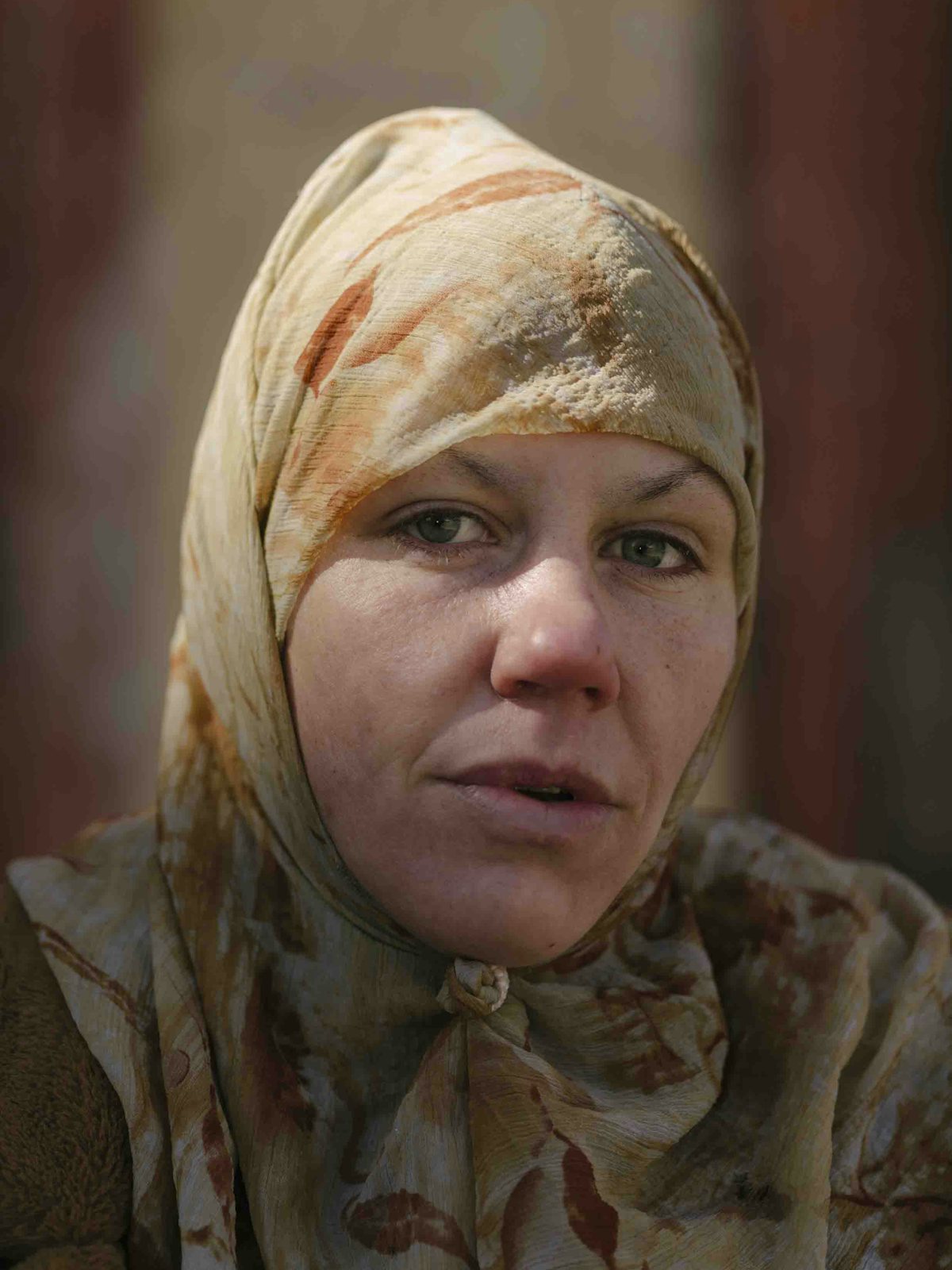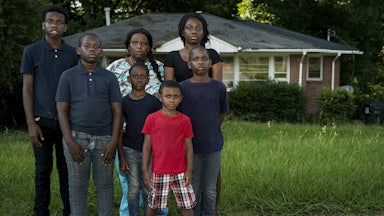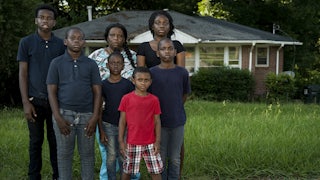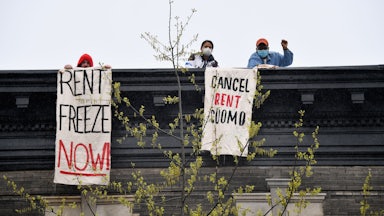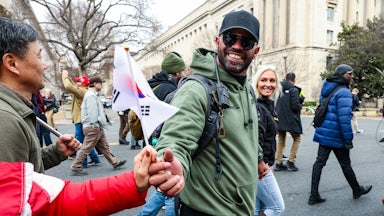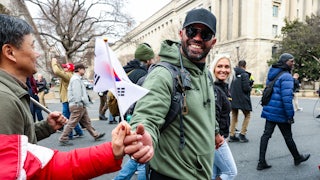In late June, in a video on the news site Unicorn Riot,
the activist Jennifer
Bennetch was standing around,
waiting to announce an occupation. The video showed her in front of the headquarters for the Philadelphia
Housing Authority, wearing a fanny pack and a colorful print hijab, bouncing
anxiously on her heels, then glancing over her shoulder as if to make sure the
coast was clear. Yet once she began, she spoke calmly
and deliberately, proceeding almost without pause. The housing authority, she explained, owns hundreds of row
houses in North Philadelphia. Over the past decade, some of the houses
had been boarded up and some sold off to developers. She had a list. A number of the boarded-up houses, she revealed, weren’t
empty: Families had been living in them since
March.
The video caused a sensation. News outlets called Bennetch and asked, dumbfounded, how she’d done it. The Philadelphia Housing Authority sent her a cease and desist letter. Over the ensuing months, a raft of stories were written about the occupied homes, and by the end of the fall, in a surprising victory, the city agreed to turn over 50 houses to a community land trust that Bennetch would help run. “Everyone tells me I’m a planner,” Bennetch said to me about her organizing strategy. “I’m not a planner. I just do shit.”
Such self-effacement, I came to find, is typical for her. She is known as a passionate, outspoken activist, but when not behind a bullhorn she avoids drawing attention to herself, holding her shoulders in the relaxed, slightly slumped posture of a tall person.
Bennetch’s self-description undersells her vision and know-how, but it isn’t wrong, exactly: She moves fast and trusts her instincts. The canny publicity strategy of the videos had been cooked up only the day before, at a separate yet equally dramatic front in Philadelphia’s pandemic-induced housing crisis: a two-week-old encampment of more than a hundred people on the Benjamin Franklin Parkway. The encampment was located in a tony neighborhood within spitting distance of the Philadelphia Museum of Art, the Rodin Museum, and a Whole Foods. Until that June day, Bennetch hadn’t drawn a direct connection between the Parkway and the empty houses owned by the housing authority. She merely saw them as two situations she was involved in.
The city was trying to negotiate with Bennetch and other activists in order to shut the camp down. The problem with this, she and the others knew, was that there was nowhere else for the people in them to go. Since the lockdown in late March, shelters had become a coronavirus risk. Philadelphia, like other cities, began putting those without housing in hotels, but there simply weren’t enough hotel rooms for everyone. At least three different camps appeared over the course of the ensuing months. When in short order the city evicted those camps, Bennetch watched housing groups load people into vans, only to see the same people at the next encampment.
The houses, Bennetch realized, offered an immediate solution to an immediate problem. She could use the cyclical, intractable nature of the housing crisis in Philadelphia—and the fact that the city had few solutions for it—as leverage. In exchange for clearing the encampment, organizers could demand that the occupied homes be turned over to a community land trust and converted into permanent low-income housing. Bennetch saw that people were paying attention to the issues of homelessness, poverty, and racial justice as never before. If the activists could roll these issues together, they might make some progress. But they couldn’t make progress if the public wasn’t aware that the families were in the houses.
Other people she worked with weren’t as certain that the occupation should go public. Some of her fellow organizers, including Wiley Cunningham, who worked primarily to help the families get the homes in livable condition and deliver supplies, thought it might be too soon. Others thought she could get arrested. And there was a greater risk: The PHA has its own police force; if they found the families, they might toss them out on the street. But Bennetch was confident that she could protect them. She was used to hearing that her ideas were insane, improbable, or ridiculous. Usually, people admitted later that she’d been right. “I know when I have to do something,” she told me. She neglects to mention that her instincts have been honed by dealing with city agencies like PHA long enough to know how they work; she knows from experience what’s risky and what isn’t.
In the Unicorn Riot videos (there are three), Bennetch pointed out that some of the boarded-up PHA houses the families had moved into were still exceedingly livable. Often the utilities still worked; some, Bennetch told me, were in better condition than her own house. One video shows Bennetch flipping on the faucet to demonstrate that the water runs, clicking the stove to demonstrate that the gas works. A woman named Natasha lives with her children in that house. In the interview, Natasha discusses how important it has been to her family. One of her children is immunocompromised and wasn’t safe staying in a shared space, and Natasha was only allowed to bring three of her kids to shelters. Her 18- and 19-year-old son and daughter, still in high school, had been forced to go to separate men’s and women’s shelters. But the kids didn’t want to stay there, and ended up sleeping on friends’ couches and spending time on the streets. Squatting in a PHA house would allow Natasha to keep her family together.
It can be difficult for families to stay together in Philadelphia. The city has the highest rate of family separation in the country, and homelessness is the second-most common reason for separations. Something Bennetch didn’t mention in the video was that getting into these PHA-owned homes legally is almost impossible. Today, the waiting list is 47,000 families long, with a typical wait time of 13 years. The list has been closed entirely since 2013. Natasha’s best option was to apply for housing in Pittsburgh, seven hours away by bus. The idea was especially maddening given the glut of vacant buildings in Philadelphia. “There are so many empty houses just sitting there,” Natasha said. “And you’ve got all these families who need housing.”
As the months rolled by, some said that
occupations such as the one in North Philadelphia were the future of housing
activism. Keeanga-Yamahtta Taylor, an assistant professor at Princeton and a
scholar of racial inequality in public policy, told Democracy Now!, “This is a
model, a strategic model, and a tactic that should be generalized by housing
groups across the country.” But was it really replicable elsewhere? Unlike
other cities, Philadelphia doesn’t have a housing shortage; it has high
homeownership and an abundance of vacant homes. Yet nearly 400,000 people in
the city live in poverty, and among those making
less than $30,000 a year, 88 percent
spent at least a third of their income on rent. Was this the future of housing
activism, or was it something else?
Bennetch’s interest in the PHA began in 2016 with a knock
at her door. At the time, she wasn’t an activist. She was studying mass media
at the Community College of Philadelphia and living with her two children in a
house she owned with her husband, Gerald Williams-Bey. One night, during
a disagreement she and her husband were having with their neighbors, two police officers showed up at her house. Over the
course of months, as the dispute continued, Bennetch’s family regularly dealt
with these officers. A lawsuit later filed by Williams-Bey describes the
neighbors’ behavior as “non-stop hate-based harassment.” Instead of
deescalating the situation, Bennetch felt, the police
made it worse. When Bennetch went down to the
22nd Precinct to file a complaint, they told her they had no logs of
Philadelphia Police officers responding to a call at her house. So who were the
two officers with badges, guns, and a squad car? When she saw the vehicle
again, she noticed the numbering was off: Instead of a 22 for the 22nd precinct, it said 96. After some digging, she found out that the car belonged
to the PHA’s police department, which is tasked
with enforcing laws and investigating crimes within the PHA system. Bennetch was shocked to discover that PHA had its own
police force. (Nationally, it is relatively uncommon. Housing authorities in
other cities, like the New York City Housing Authority, once had police forces
but have since disbanded them.)
Bennetch knew that while her immediate neighbors’ row houses looked like hers, they were owned by the PHA, a New Deal–era organization established in 1937 (one of 3,300 such housing authorities in the country) whose job is to maintain the city’s public housing stock. Typically, the housing authority built and managed large high-rise apartments as public housing, but beginning in the 1970s, it—like housing authorities in many other cities—began acquiring “scattered site” properties in addition to its more traditional public housing projects. Scattered site properties had the advantage of destigmatizing public housing because, unlike a housing project, no one could tell who they belonged to. In Philadelphia, the majority of these properties are in the largely poor area of the city known as North Philadelphia.
When Bennetch went to elected officials to figure out why PHA had its own police force, why they looked exactly like the Philadelphia Police Department, and why they were bothering her, everyone pointed the finger at someone else. City officials, she told me, said that PHA was run by the state. The state said the federal government ran the agency. And then she’d call a federal legislator, who’d say the feds fund PHA but it’s overseen by the city. “It was a wild goose chase,” she shrugged. (Her family eventually sued PHA during their investigation; the case is pending.)
Bennetch got so frustrated by her failure to make any headway that she switched her major in school to paralegal studies, a course of study that gave her access to the research tools Westlaw and LexisNexis and to the Jenkins Law Library. Bit by bit, she uncovered a byzantine structure of power. PHA, she discovered, was federally funded, as she’d been told; it had state police powers; and it was overseen by the mayor, who had the most power, she determined, because he or she appoints the Board of Commissioners, who appoints the CEO. The mayor could remove the board at any time. It was all complicated enough to give each agency plausible deniability, or at least complicated enough that few really understood how it worked. Dr. Susan Popkin, an Institute fellow at the Metropolitan Housing and Communities Center, explained that PHA, like all housing authorities, is an independent municipal corporation. While housing authorities can and often do work with local governments, they are designed to operate independently.
In Philadelphia, the housing authority is largely disconnected from city government. According to one person who is familiar with both PHA and other municipal development agencies in Philadelphia, PHA has its own executive director and senior staff, as well as its own budgets, procurement policies, and labor union relationships that, for the most part, are separate from their counterparts in municipal government. It operates according to its own prerogatives.
At one of the public meetings of the Board of Commissioners, which Bennetch began attending (in roughly five years, she’s never missed one), she learned that PHA was auctioning off many of its scattered site houses. She also noticed, separately, that the houses that college students in her neighborhood were now living in used to be owned by PHA.
Beginning in 2011, the PHA began selling off thousands of “nonviable” properties in auctions in order to raise money. The first year, PHA sold 341 properties for $6.4 million. In part, this was due to the fact that the U.S. Department of Housing and Urban Development had suspended millions in funding and, in 2011, after allegations of corruption and sexual harassment, placed PHA in receivership. The former executive director, Carl Greene, alone cost the agency at least $500,000 to settle sexual harassment lawsuits; his $17,000 “diversity awareness” training famously featured belly dancers and yodelers. In 2013, the Board of Commissioners appointed the housing authority’s current president and CEO, Kelvin Jeremiah, a move that brought the agency back under local control. The auctions continued.
Housing authorities nationwide are suffering from decades of budgetary shortfalls, but auctioning off homes to raise money is an unusual tactic. Popkin, the Metropolitan Housing Center fellow, told me she was surprised to hear of it. (Many housing authorities are, in fact, using new funds to acquire properties.) The auctions were primarily happening in North Philadelphia, the neighborhood where Bennetch has lived since she moved in with her husband in 2010. There, three-story nineteenth-century brick row houses line narrow streets, frequently interrupted by grassy lots where buildings used to be. Vacant houses are common. Near where Bennetch lives sits a fenced-off church with a collapsed roof. “It wasn’t gentrified yet when I came,” she said, “and I was really one of the only white people around.” Yet when she moved in, she felt accepted by her neighbors. She recalled more corner stores at the time, more Black-owned businesses.
Bennetch eventually began to sense that the community she valued was slipping away. Attending the PHA board meetings, she noticed a connection between the changes in her neighborhood and the actions of the housing authority. Longtime residents were leaving their homes; sometimes the houses were boarded up. Why was a perfectly good structure being condemned? Bennetch and her husband recycle scrap metal for a living, so she spends days riding around North Philadelphia. Every time she saw a boarded-up house in her neighborhood, she noted it and looked up the property record. If it was PHA, she added it to her list. The task got easier when she noticed that PHA row houses were all painted the same shade of dreary, institutional brown. One afternoon, she found 60 houses. In selling off decent properties, Bennetch observed, PHA was not only changing the character of the area; it was eliminating low-income housing. Properties were largely inhabited by students or vacant. She noticed the full effect of the change in 2018, around Christmas. The Eagles had just won a playoff game, and when she went out for her nightly walk, the streets were eerily quiet; the Temple students were all home on winter break. She could have been snatched off the street, she told me, and no one would have noticed.
It wasn’t always like this, Ruth Birchett told me. Birchett is a longtime resident of North Philadelphia and a community organizer with Heritage CDC. “My family has been in this neighborhood 70 years. Same house, same phone number.” When she was a child, she said, “we didn’t have vacant lots, we didn’t have abandoned buildings, we didn’t have any of that.” That is the legacy of divestment in the community; the auctions and new development a sign of gentrification. Birchett said it was happening fast.
Bennetch hoped she could use the list she was making for a lawsuit that might help halt or slow the transformation. If she sued PHA for neglecting the neighborhood and encouraging blight, perhaps the list of properties could prove that the structures weren’t “nonviable” as PHA said they were. But she couldn’t find anyone to take the case. In lieu of direct legal recourse, Bennetch took action. In April 2019, she set up camp at PHA’s new $45 million office in North Philadelphia, and for five months slept in a tent and protested in front of the complex. Friends and community members stopped by to offer support and help protest. Bennetch wanted not only to bring light to the dispossessions but to demand changes to the PHA police force. She called her project Occupy PHA. To some degree, the pressure she applied was successful: PHA agreed to differentiate the uniforms of its police officers and the appearance of its cars from those of the city’s police department. It didn’t, however, agree to a moratorium on selling houses.
Occupy PHA made Bennetch a known and respected figure in her community. People messaged her Facebook page when they had problems. The following winter, she began considering the idea of squatting. She was aware of the Moms 4 Housing protest in Oakland, California, and thought that the best way to show that PHA was ridding itself of perfectly good housing would be to move people into the empty homes.
Philadelphia, it should be said, has a long history of squatting. In the 1960s, the loss of manufacturing combined with white flight to the suburbs depopulated the urban core, and vacant properties proliferated. In the 1980s, church leaders and the future mayor, John Street, noticed the abandoned, neglected houses and encouraged residents to squat. For a major city, Philadelphia has fairly permissive “squatter’s rights,” which often entitle someone who has stayed in a house for more than two weeks due process eviction through the courts instead of forcible eviction by police for trespassing. In many cities, squatters need to stay for more than 30 days for such rights to kick in. More than 12,000 vacant units exist in Philadelphia. Only Baltimore and Detroit have more.
Nonetheless, before the pandemic struck in 2020, Bennetch couldn’t find anyone to move into the houses. For most people, the risk seemed too great, a caution Bennetch understood well. She knew the PHA police had ejected people for trespassing in the past. She sympathized, too, because for seven years, until 2010, Bennetch herself had been homeless. She had grown up in foster care, and, like many other young people aging out of the system, she ended up living outside and in shelters. During this time, she found the city’s social services unable to help her break the cycle. “They were all useless,” she told me. “We were sleeping at City Hall, and people were walking past us to get awards for housing advocacy.” She got out only by moving in with her husband, to the house he owned. She had experienced firsthand, in other words, an extraordinarily simple solution to homelessness that is also the one many experts consider the best: getting out of a temporary shelter and into a home where you can stay permanently.
In March 2020, moms started messaging Bennetch through the Occupy PHA page on Facebook, asking what they should do. The shelters had become unsafe, and there was nowhere else for their families to go. They had grown desperate enough to take the risk. On March 23, the same day the city evicted an encampment under the convention center and a day after it issued stay-at-home orders, Bennetch helped one of the families move into the first house. She went to protest the encampment clearance, then quietly left to go help with the move.
Over the next four months, Bennetch moved eight more families into viable houses.
On May 25, Minneapolis police officer Derek
Chauvin killed George Floyd, and Philadelphia—with its own long history of violent, racist
policing—erupted in protests. These protests, as in other cities, quickly
converged with the housing crisis. In Philadelphia, the racial aspect of the
housing crisis was particularly clear. The majority of the 900 people who live
outside and the 5,600 who live in temporary shelters are Black and brown.
On June 7, in Bennetch’s side yard, three activists she had come to know over the past couple years met to discuss what they could do. Alex Stewart, of the Workers Revolutionary Collective, suggested they start a protest camp, so the city couldn’t evict it without violating the inhabitants’ First Amendment rights. The group needed to find a conspicuous location, and proposed a baseball field in the wealthy neighborhood of Logan Square. It seemed like a long shot, but they agreed it might be the only option. The next Wednesday, Alex and a few others set up camp on the ball field. The police arrived and ordered them to leave but, for whatever reason, did not chase them away. By the weekend, more than a hundred people had camped out on Benjamin Franklin Parkway. “I don’t think they thought it would grow that big that fast,” Bennetch reflected.
Within days, the city turned to Bennetch and her fellow organizers to negotiate an end to the camp. In their first negotiation with Eva Gladstein, the deputy managing director of Health and Human Services for the City of Philadelphia, the city appeared amenable to their demands, agreeing to sanction the encampment and perhaps pilot the creation of a tiny-house village. But the city didn’t exercise any authority over PHA, and PHA wasn’t participating in the talks. Bennetch realized that if they were going to force PHA to the table, they needed to go public. She also established a second camp, on a plot of vacant land owned by PHA, closer to her house. In July, PHA showed up to the table.
By August, the camps had turned into a flashpoint, but the negotiations were fizzling. The mayor publicly said he thought the conversations were “fruitless” and threatened to clear the camps. The announcement spooked the residents, but nothing happened. The encampment dragged on into September.
People familiar with housing issues, such as the legal director of the National Homelessness Law Center, Eric Tars, told me at the time that the Parkway encampment was unprecedented: a tent city with a list of housing demands. Of course, protest camps themselves are not new. They date all the way back to the post–World War I era, when veterans camped on the lawn of the White House and demanded their pensions. But it seemed Philadelphia was demonstrating a new way forward for housing activism. Unlike the residents of autonomous zones in Seattle or the sanctuary camps in Minneapolis, these people had a much more specific goal in mind and a list of demands. What most couldn’t see, of course, was that this goal derived much of its clarity from Bennetch’s years-long obsession with the PHA.
During the summer, Bennetch discovered information that offered more key leverage: The PHA was on a deadline. At the second camp, which was on land where the housing authority planned to build a multi-use parking garage, grocery store, and apartment complex, Bennetch helped file an injunction to stop any eviction. In response, the housing authority said it would lose funding in new market tax credits if it didn’t deliver the land to developers by October 6. For PHA, the clock was ticking.
On September 24, the encampment organizers
were set to meet with PHA in the evening to discuss a solution. They were in
the midst of their third and final eviction. That morning, Bennetch got an
unexpected call from the CEO of PHA, Kelvin Jeremiah. He wanted to talk
privately with her—could she grab a pen and paper? PHA was prepared to offer
her nine houses on one block in North Philadelphia, fully rehabbed and paid for
by the agency. While the houses were getting fixed up, they would provide a
training program for encampment residents so they could qualify for union jobs
in the trades. Jeremiah also agreed to reform the PHA’s police force, put a
moratorium on sales for profit for a year, protect the squatters, pilot a study
of the impact of land sales on the community, and continue to negotiate in good
faith. In return, Bennetch would not be allowed to tell anyone about the
agreement and would have to have the second camp cleared by Monday, less than
four days away. (The agency confirmed that Jeremiah spoke with Bennetch prior to the announcement of any agreements.)
It was a dizzying turn of events. At the public negotiation later that day, Bennetch was subdued. Her fellow negotiator, a former attorney named Sterling Johnson who had previously worked for institutional housing agencies in the city, wondered why he was doing most of the talking. Wiley Cunningham, who was listening on a speaker at the camp, was surprised Bennetch wasn’t being more combative. “It just kinda felt like everyone wanted to get it over with,” he said.
Bennetch told the others that she just needed time to process, though she wouldn’t say about what. She was in shock. “It all got weird. We suddenly went from being arch enemies to having these check-ins about our deals.” The turn of events was more or less a surprise. “Up until the day I got that phone call, we had no hope we would get anything,” she explained. “For the last four years I’ve been doing this, we’ve been ignored by everybody.” The other organizers I talked with echoed this sentiment.
That weekend, she moved the people who remained at the second camp into squats and secured the deal. PHA posted a press release, and got its funding.
A week later, while Bennetch was walking downtown to go grocery shopping, she got another call from Jeremiah. Could she find a quiet place to take a conference call with Tumar Alexander, the managing director of the city? She sat down on the steps of City Hall to take the call. Bennetch recalls that Alexander told her he had an offer, that only three people in the city knew about the deal, and that they were all on the phone call. They would transfer 25 houses from PHA and 15 houses owned by the city into a community land trust, as well as a number of rapid rehousing units and a tiny-house village. In exchange, the city needed the massive camp on Benjamin Franklin Parkway cleared in six days.
Bennetch felt an obligation to take the deals and help the city clear the camp. The ranks of the people she was working with had thinned. Frustrated or exhausted, some left temporarily for health reasons, and some dropped out entirely. Many activists thought the group should have pushed to get more. This didn’t seem like an option to Bennetch. “If we don’t do it,” she said, “everybody’s getting fucked up by the police and getting nothing.”
After the second deal was signed on October 11, the city announced in its press release that the camp would close, which set off a panic among residents. From then on, “it was a circus,” Bennetch says. Anxious residents and activists who didn’t understand what was going on reacted violently to attempts to clean up the trash. Some volunteers had imagined the camps would continue indefinitely, but in Bennetch’s mind, they were always meant to be temporary: They were a disaster response site for the housing crisis and a base for protest—that is, they were a means to an end, not an end in themselves.
One day, tired and largely alone, Bennetch called the City to quit what was a completely unpaid position as camp clearing liaison, but they begged her—“a nobody,” as she put it—to stay. Reluctantly, she agreed. On the camp’s last day, October 26, just two people remained. Bennetch checked Facebook and saw that Philadelphia police had just killed Walter Wallace. It was just chance, she felt, that police hadn’t killed anyone at the camps. Sinking into her chair, she felt dazed.
In December, sitting in Bennetch’s kitchen while her kids
ran in and out for snacks, I asked her what it meant
for the neighborhood for these houses to be turned over to a community land
trust on whose board she now serves. “You go around and see the former PHA
houses, and they’ve mostly been demolished to make a four-story house with a
roof deck,” she said. The agreement had given people homes and also stopped
these changes to the character of the neighborhood.
Running the community land trust, she thought, was going to be a challenge. The position, which she shared with Sterling Johnson, was unpaid. The trust intended to house families and other people in the community who need homes but might, say, have a criminal record or use drugs, so may not be eligible for federal grant money from HUD or other nonprofits, because that money stipulates that it cannot be used to house people with criminal records; many nonprofits set similar stipulations. Bennetch was hoping to reduce costs by inviting residents to enter programs that would train them to fix the buildings themselves. Still, some estimates put the rehabilitation for some buildings in the tens or hundreds of thousands of dollars. The long-term viability of the project was still an open question.
The other looming question is whether what happened in Philadelphia could be replicated in other cities. On a superficial level, the answer is murky. When I first went to Philadelphia, many people stressed the uniqueness of the city. The tremendous number of abandoned homes owned by the government makes it possible for the city to turn them over to groups that want to do the work of making them low-income housing. And nothing had changed for the squatters until their situation converged, through Bennetch’s efforts, with a highly public encampment. But Bennetch had been working on the problem of boarded-up houses in her neighborhood for years before she found any success.
However, Philadelphia doesn’t have to be the exception. City and state governments across the country publicly own land and houses that could be turned over to community groups. Scattered site housing owned by housing authorities is common, as well. It’s possible that instead of letting homes go abandoned, the public could pressure governmental organizations to buy these properties and turn them into public low-income housing. Of course, that path would also require citizens to demand that the federal government—through HUD—provide exponentially more funding to housing authorities. In Philadelphia, public encampments proved one effective method of making these demands, but any number of other tactics could work. Other cities are also rife with vacant private-market units; one report put the number of such units in Los Angeles at 93,000.
These tactics could also potentially be applicable to private market housing, as well. In Oakland, Moms 4 Housing occupied a house owned by a private developer and, through a public protest quite similar to the one in Philadelphia, forced the developer to turn the house over to them. A group of renters in Minneapolis fought their landlord, effectively squatted through a torrent of eviction notices, and won control over their apartments.
Yet even if the lessons are not directly applicable, Bennetch hoped that people would look to the success of the project and draw inspiration. “If we fail,” she said, “that’s gonna be brought up when anyone else wants to try this elsewhere in Philly or elsewhere in the country.” And while not everyone has her nose for legal research or her borderline-photographic memory for statutes, the focused, indefatigable nature of advocacy is replicable. She is animated by a deep affinity for her community and fueled by firsthand knowledge of the problem. When she set out to clear the camp on PHA land, her actions were about housing people she knew and cared about.
Possibly more important, Bennetch has worked on this one specific issue long enough that she now understands the system in general. Over five years, she uncovered how power works in one American city and, to a degree, manipulated it. And instead of making her jaded, the experience has given her something like righteous clarity. In an email to the city on July 9, she wrote that the organizers and encampment residents have lived in the city for decades: “We know its capabilities. While the city government claims that it does not possess the resources or powers to provide emergency housing for its thousands of residents living on the streets and in shelters, we know that this is simply a lack of political will.” The following months proved her more than correct.
This article was supported by the Economic Hardship Reporting Project.
